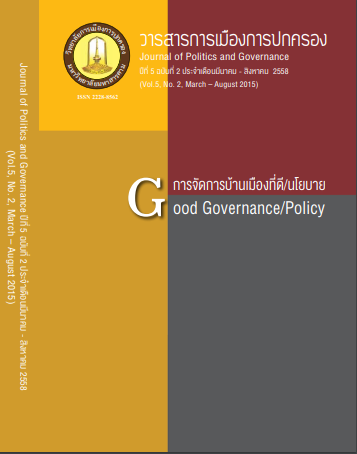Compliance with, and Effective Implementation of Multilateral Environmental Agreements: Looking Back at the Transboundary Haze Pollution Problem in the ASEAN Region
Main Article Content
บทคัดย่อ
“Smoke haze” is a transboundary pollution problem which severely affected the Southeast Asian region during its most devastating occurrence in 1997-1998. As a response, the ASEAN implemented its Regional Haze Action Plan in 1997 backed up by a legal framework called ASEAN Agreement on Transboundary Haze Pollution which took effect in 2003. Looking back, this paper will attempt to explain the regulatory ability of the ASEAN to solve the problem by investigating the compliance of four countries (i.e., Indonesia, Malaysia, Singapore, and the Philippines) with the regional anti-haze pollution measures, and their implementation of domestic laws to stop forest fires.
Article Details

อนุญาตภายใต้เงื่อนไข Creative Commons Attribution-NonCommercial-NoDerivatives 4.0 International License.
เอกสารอ้างอิง
Books and Monographs:
Andresen, S. et al. (1995). Regime, the state and society: Analyzing the implementation of international environmental commitment. IIASA Working Paper WP-95-43. Laxenburg, Austria: International Institute for Applied Systems Analysis.
Cameron, J., et al., eds. (1996). Improving compliance with international environmental law. London, Earthscan.
Chayes, A. & Chayes, A. (1993). On compliance. International Organization, 43, 175-205.
Florano, E. (2003). Assessment of the ‘strengths’ of the new ASEAN Agreement on Transboundary Haze Pollution. International Review of Environmental Strategies ,4 (Summer), No. 1, 127-147.
Fisher, R. (1981). Improving compliance with international law. Charlottesville. VA: University Press of Virginia.
Heil, A. & Goldammer, J. (2000). Smoke-haze pollution: A review of the 1997 episode in Southeast Asia. Regional Environmental Change. 2 (1), 24-37.
Kay, D. & H., Jacobson. (1983). Environmental protection: The international dimension. London: Allenheld Osmun.
Kimball, L. (1996). Treaty implementation: Scientific and technical advice enters a new stage. Washington, D.C.: The American Society of International Law.
Mitchell, R. (1996). Compliance theory: An overview. In Improving compliance with international environmental law, pp. 3-28. Edited by James Cameron, Jacob Werksman, and Peter Roderick. London: Earthscan Publications Ltd.
Najam, A. (1995). Learning from the literature on policy implementation: A synthesis perspective, WP-95-61. Laxenburg, Austria: International Institute for Applied Systems Analysis.
Peterson, M. J. (1997). International organizations and the implementation of environmentaleRegimes. In Global Governance: Drawing Insights from the Environmental Experience, pp.115-151. Edited by Oran R. Young. Cambridge, MA: The MIT Press.
Pressman, J. & Wildavsky, A. (1973). Implementation: How great expectations in Washington are dashed in Oakland; Or why it’s Amazing that federal programs work at all. Berkeley: University of California Press.
Qadri, S. T., ed. (2001). Fire, smoke, and haze. The ASEAN response and strategy. Manila, Philippines: ASEAN and ADB.
Raustiala, K. (1997). States, NGOs, and international environmental institutions.” International Studies Quarterly 41 (4): 719-740.
Raustiala, K. & Victor, D. (1998). Conclusions. In The implementation and effectiveness of international environmental commitments: Theory and practice, pp. 657-707. Edited by David G. Victor, Kal Raustiala, and Eugene B. Skolnikoff. Cambridge, Massachusetts: The MIT Press.
Rein, M. &Rabinovitz, F. (1978). Implementation: A theoretical perspective. In American politics and public policy, pp. 307-335. Edited by Walter Dean Burnham and Martha Wagner. Weinberg. Cambridge, MA: MIT Press.
Roginko, A. (1994). Domestic compliance with international environmental agreements: A review of current literature. IIASA Working Paper WP-94-128. Laxenburg. Austria: International Institute for Applied Systems Analysis.
Rosenberg, D. (1999). Environmental pollution around the South China Sea: Developing a regional response. Contemporary Southeast Asia, XXI (1): 119-145.
Shelton, D., ed. (2000). Introduction: Law, non-law and the problems of ‘soft law’. In Commitment and compliance: The role of non-binding norms in the international legal system, pp.1-20. New York: Oxford University Press.
Underdal, A. (1980). The politics of international fisheries management: The case of the Northeast Atlantic. Oslo: Universitetsforlaget.
UNEP/NCAR/UNU/WMO/ISDR Assessment. (2000). Lessons learned from the 1997-98 El Niño: Once burned, twice shy? (Tokyo: United Nations University Press); and Heil, Angelika & Goldammer, Johann G. (2000), Smoke-Haze Pollution: A Review of the 1997 Episode in Southeast Asia. Regional Environmental Change, 2 (1), 24-37.
Van Meter, D. &Van Horn, C. (1975). The policy implementation process. Administration and Society, 6 (4): 447-448.
Victor, D. et al., eds. (1998). Introduction and overview. In The implementation and effectiveness of international environmental commitments: Theory and practice, pp. 1-46. (Cambridge, Massachusetts: The MIT Press).
Weiss, E. (2000). Conclusions: Understanding compliance with soft law.” In Commitment and compliance: The role of non-binding norms in the international legal system, pp. 535-553. Edited by Dinah Shelton. Oxford: Oxford University Press.
Weiss, E. & Jacobson, H., eds. (2000). Engaging countries: Strengthening compliance with international environmental accords. Cambridge, Massachusetts, London, England: The MIT Press.
Young, O. (1999a). Hitting the mark: Why are some international environmental agreements more successful than others. Environment, 41 (8): 20-29.
Young, O. (1999b). The effectiveness of international institutions: Hard cases and critical variables. In Governance Without Government: Order and Change in World Politics. Edited by James Rosenau and Ernst Otto-Czempiel. Cambridge: Cambridge University Press.
Young, O. (1991). On the effectiveness of international regimes: Defining concepts and identifying variables. A working paper prepared for use by the Darthmouth-based research team studying the effectiveness of international regimes.
Young, O. (1989). International cooperation: Building regimes for natural resources and the environment. Ithaca: Cornell University Press.
Young, O. (1982). Resource regimes: Natural resources and social institutions. Berkeley: University of California Press.
Young, O. (1979). Compliance and public authority: A theory with international applications. Baltimore, MD: Johns Hopkins University Press.
Young, O. et al. (1991). Global envrionmental change and international governance. Summary and recommendations of a conference held at Dartmouth College, Hanover, New Hampshire, June.
Internet:
ASEAN Specialized Meteorological Center (ASMC). (1999-2002). “Update on regional weather and smoke haze.” Submitted to the various RHAP-related units of ASEAN.
ASEAN Specialized Meteorological Center (ASMC). (2006-2014). “Cumulative hotspot count charts.” Retrieved 05 October 2014, from http://www.weather.gov.sg/wip/c/portal/layout?p_l_id=PUB.1003.613 .
ASEAN Specialized Meteorological Center (ASMC). (2014, 04 October). “Latest haze map.” Retrieved 04 October 2014, from http://www.weather.gov.sg/wip/web/ASMC.
Interviews:
Ginting, Longgena. (2003). Interview conducted on 11 August. WALHI Office, Jakarta, Indonesia.
Ong Keng Yong. (2003). Interview conducted on 7 August. ASEAN Secretariat Headquarters, Jakarta, Indonesia.


